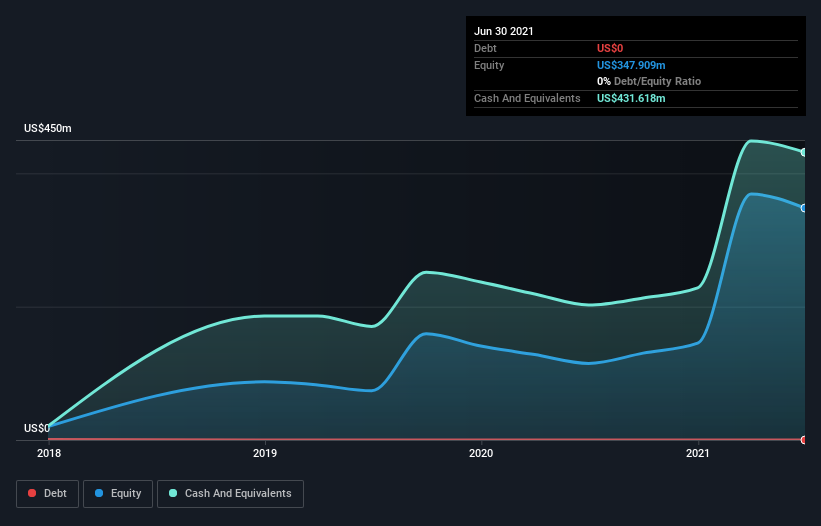- United States
- /
- Biotech
- /
- NasdaqGM:MORF
We're Not Worried About Morphic Holding's (NASDAQ:MORF) Cash Burn

Just because a business does not make any money, does not mean that the stock will go down. Indeed, Morphic Holding (NASDAQ:MORF) stock is up 142% in the last year, providing strong gains for shareholders. Having said that, unprofitable companies are risky because they could potentially burn through all their cash and become distressed.
In light of its strong share price run, we think now is a good time to investigate how risky Morphic Holding's cash burn is. In this article, we define cash burn as its annual (negative) free cash flow, which is the amount of money a company spends each year to fund its growth. We'll start by comparing its cash burn with its cash reserves in order to calculate its cash runway.
See our latest analysis for Morphic Holding
When Might Morphic Holding Run Out Of Money?
A company's cash runway is the amount of time it would take to burn through its cash reserves at its current cash burn rate. In June 2021, Morphic Holding had US$432m in cash, and was debt-free. Importantly, its cash burn was US$49m over the trailing twelve months. So it had a cash runway of about 8.7 years from June 2021. While this is only one measure of its cash burn situation, it certainly gives us the impression that holders have nothing to worry about. The image below shows how its cash balance has been changing over the last few years.

How Well Is Morphic Holding Growing?
We reckon the fact that Morphic Holding managed to shrink its cash burn by 24% over the last year is rather encouraging. But it was the operating revenue growth of 108% that really shone. It seems to be growing nicely. Clearly, however, the crucial factor is whether the company will grow its business going forward. So you might want to take a peek at how much the company is expected to grow in the next few years.
How Easily Can Morphic Holding Raise Cash?
We are certainly impressed with the progress Morphic Holding has made over the last year, but it is also worth considering how costly it would be if it wanted to raise more cash to fund faster growth. Companies can raise capital through either debt or equity. One of the main advantages held by publicly listed companies is that they can sell shares to investors to raise cash and fund growth. We can compare a company's cash burn to its market capitalisation to get a sense for how many new shares a company would have to issue to fund one year's operations.
Morphic Holding has a market capitalisation of US$2.3b and burnt through US$49m last year, which is 2.2% of the company's market value. That means it could easily issue a few shares to fund more growth, and might well be in a position to borrow cheaply.
So, Should We Worry About Morphic Holding's Cash Burn?
It may already be apparent to you that we're relatively comfortable with the way Morphic Holding is burning through its cash. For example, we think its revenue growth suggests that the company is on a good path. Its cash burn reduction wasn't quite as good, but was still rather encouraging! Taking all the factors in this report into account, we're not at all worried about its cash burn, as the business appears well capitalized to spend as needs be. Taking a deeper dive, we've spotted 3 warning signs for Morphic Holding you should be aware of, and 1 of them is a bit concerning.
Of course, you might find a fantastic investment by looking elsewhere. So take a peek at this free list of companies insiders are buying, and this list of stocks growth stocks (according to analyst forecasts)
New: Manage All Your Stock Portfolios in One Place
We've created the ultimate portfolio companion for stock investors, and it's free.
• Connect an unlimited number of Portfolios and see your total in one currency
• Be alerted to new Warning Signs or Risks via email or mobile
• Track the Fair Value of your stocks
This article by Simply Wall St is general in nature. We provide commentary based on historical data and analyst forecasts only using an unbiased methodology and our articles are not intended to be financial advice. It does not constitute a recommendation to buy or sell any stock, and does not take account of your objectives, or your financial situation. We aim to bring you long-term focused analysis driven by fundamental data. Note that our analysis may not factor in the latest price-sensitive company announcements or qualitative material. Simply Wall St has no position in any stocks mentioned.
Have feedback on this article? Concerned about the content? Get in touch with us directly. Alternatively, email editorial-team (at) simplywallst.com.
About NasdaqGM:MORF
Morphic Holding
A biopharmaceutical company, discovers and develops oral small-molecule integrin therapeutics for the treatment of autoimmune, cardiovascular, and metabolic diseases, as well as fibrosis and cancer.
Flawless balance sheet moderate.
Market Insights
Community Narratives




